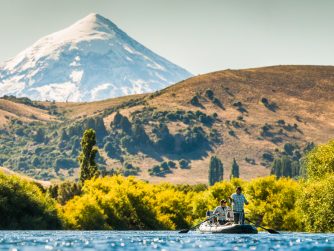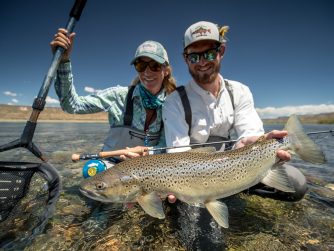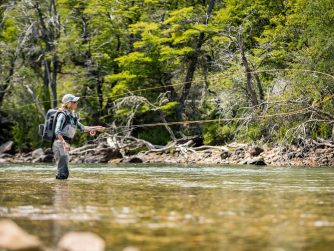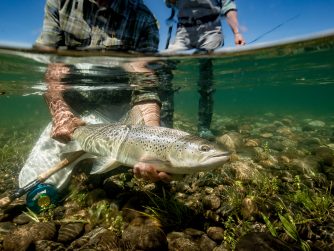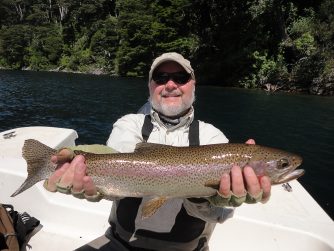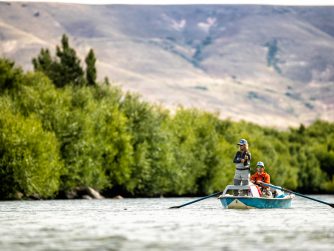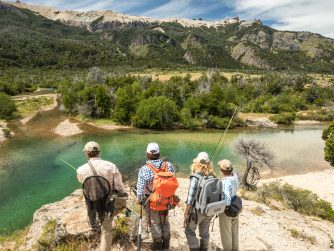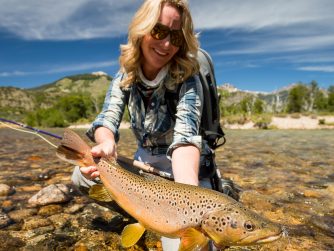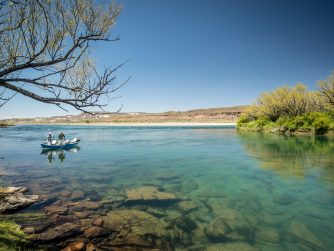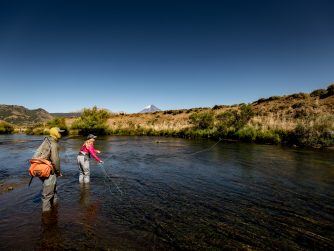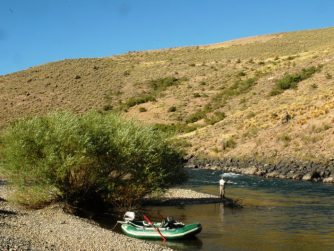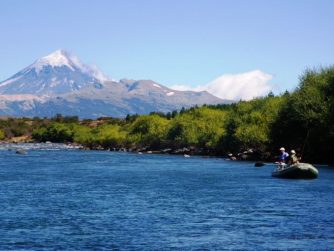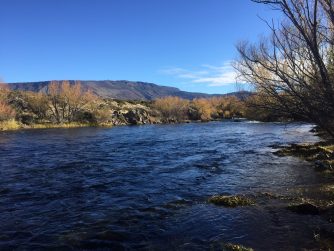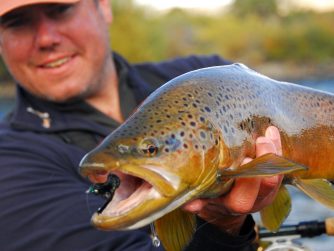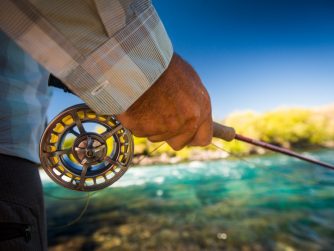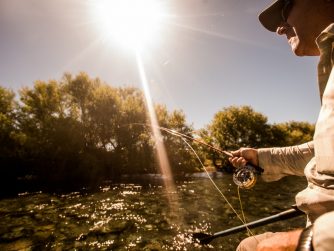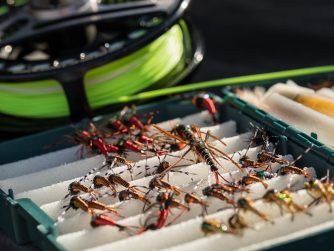Fly Fishing in Patagonia
People often compare Patagonia trout fishing to what you might find in Montana or Wyoming. Sure, there are ample rivers populated with big browns and bright rainbows on both sides of the hemispherical divide, plus some climactic consistencies, but that’s where most of the comparisons end. Patagonia’s rich trout culture has its own historical origins, its guides serve wine and asado instead of PBR and PB&Js, and everything from the pace of play to the seasonal hatches have distinct flavors.
When you’re ready for a taste, Northern Patagonia Lodge has front-door access to a diverse lineup of Northern Patagonia’s top trout waters. Browns and rainbows, as well as brook trout and landlocked salmon on specific waters, all thrive here. And every day you’ll fish untouched beats by raft, horseback, or on your own two feet, depending on your preferences.
The picturesque Chimehuin River is a wade and raft-friendly mainstay that meanders and braids for more than 30 miles before it meets another legend: the Collon Cura River. Nearby you’ll find small, technical streams offering dry-fly, streamer, and nymphing opportunities. And in addition to sprawling rivers and intimate streams, this is a land of enchanting lakes. Trophy Stillwater includes the Tromen, Huechulafquen, Epulafquen, Verde, and Curruhe—to name a few. Each has its own seasonal intricacies and all are known for sizeable trout. In total, the area is home to more than 20 of these trout-rich lakes.
Chimehuin River
The fabled Chimehuin River is the most famous of all Patagonian rivers and home of endless stories of the monster trout that live in its productive waters. The Chimehuin is born on Lake Huechulafquen and flows for 40 trout-rich kilometers until it meets the Collon Cura River.
The Chimehuin also referred to as “the Cathedral of Patagonia Fly fishing” is the place where fly fishing in Patagonia began.
Made famous by Joe Brooks and other fly-fishing gods during the ’60s, the Chimehuin put Patagonia on the fly-fishing maps of the world.
The mythical mouth or “Boca” gather fishermen from all around the world to catch the gigantic trout that every year migrates from the lake to the river to spawn. The Chimehuin is very productive with all fly fishing techniques be it dry, nymph or streamer and every corner may give you the fish of a lifetime. We can float right from the Lodge or drive and wade the many productive pools the Chimehuin has to offer.
Malleo River
About 20 km from Northern Patagonia Lodge you’ll reach the mid-reaches of the Malleo River. Regarded as one of the top 3 rivers in Patagonia, the Malleo is born on the very productive Lake Tromen on the northern foothills of Lanin Volcano.
Upper Malleo
The upper parts of this river are not easy to fish due to heavily dense vegetation and steep gradient but very rewarding. The upper part is home of lots of small trout and some large resident fish and migratory rainbow and brown trout. This is small pocket water on the heart of Parque Nacional Lanin.
Mid and lower Malleo
We will concentrate on the lower reaches until its confluence with the Alumine River; on the Mapuche Indian Reservation; where it is easily waded, has abundant hatches throughout the season, and holds large numbers of nice-sized resident rainbow and brown trout.
It is a dry fly paradise! You can fish all day long in different pools and runs sight fishing for large trout is possible if your eyes are good and your casting better.
It is also a river that will reward the streamer fishermen with large brown trout, especially during low-light conditions.
Collon curá River
The super-productive Collon Cura River is born from the union of the Chimehuin and Catan Lil Rivers and flows for about 70 km until it reaches the Piedra del Aguila Reservoir.
Besides the undisputed quality of the fishing, this is the place where it’s possible to see the unique wildlife from Patagonia. Just look up and you’ll see condors, eagles, ducks, falcons, and raptors. Look to the banks and you may spot red deer, red and grey foxes, guanacos, rheas, otters, and more.
Due to the proximity to the reservoir, it’s a great river to Spey cast large streamers in search of large migratory brown trout (landlocked version of Rio Grande’s sea run browns), especially early and late in the season.
For the angler who’s done it all and wants to catch that extra fish, there are Percas and Pejerrey Patagonico in abundance, especially during warm summer days.
Alumine River
The Alumine river is born in the homonymous lake and flows for 160 trout-infested waters until it meets the Catan Lil River and forms the Collon Cura.
The most productive stretch is downstream from Pilo Lil all the way to Catan Lil. This is the place most guides call “the fish factory” where large concentrations of trout feed on well-marked lanes or below the ever-present willows that cover its banks.
It is not uncommon to hook 50 + fish on a day’s float, with impressive average-size fish that will attack a well-placed dry fly. Even though you may fish dries and nymphs all day long for 18” fish, swinging a streamer deep into some pools may give you some trout measured in lbs not inches. Hook in and hang on!
This is also the place where you will hook and land our native fish called Perca.
The stretch from Pilo Lil to its confluence with the Malleo is the place we choose for our multi-day float trip.
Limay River
The Limay River is an important river in northwestern Argentine Patagonia (the region of Comahue). It is born at the eastern end of the Nahuel Huapi Lake and flows in a meandering path for about 380 km, collecting the waters of several tributaries, such as the Traful, the Pichileufú, and the Collón Curá. It then meets the Neuquén River and together they become the Río Negro. At this confluence lies the city of Neuquén.
The river serves as the natural limit between the provinces of Río Negro and Neuquén.
We float the Limay River below one of their dams in search of XL migratory brown trout.
THE DAILY PROGRAM
This is a sample itinerary for the purpose of illustration only. These are the waters we typically fish from the lodge. We may vary your specific itinerary according to your fishing preferences and prevailing weather, temperature, water levels, fish migration and the opinions of our guides. We can also arrange trips to other great fisheries from the lodge.
Day 1
- Arrival in San Martin de los Andes at Chapelco Airport (around 2 p.m.)
- Drive to Northern Patagonia Lodge.
- After lunch, the fishing manager will assist anglers in the preparation of fishing equipment.
- Cocktails, appetizers, and dinner at the lodge.
Day 2
- Breakfast at the Lodge.
- After breakfast, we’ll drive to the Lower Malleo River. This section of the river is located in the Mapuche Reservation Amutuy Quime. It is wading only. There are hundreds of pools to fish all day long and then some. We’ll move around with the trucks to find the most productive runs.
- Back to the Lodge for appetizers and dinner
- Recommended rods: 4, 5 or 6 wt with floating lines and 7’ to 12’ leaders.
Day 3
- Breakfast at the lodge.
- Our day starts at the Rinconada Bridge, which spans the Collon Cura River. This is big water, like the Madison in Montana, with fish from 12 inches to several pounds. There are brown and rainbow trout and Perca, our native fish. Percas put up a nice fight, much like a brown trout, and eat whatever you throw at them. We’ll float most of this river and we’ll stop and wade the many channels formed around the islands in the river.
- Back to the lodge for appetizers and dinner
Day 4
- Breakfast at the Lodge.
- Drive to Lake Tromen, in the shadows of Lanin Volcano and 3 miles from the Chilean border, where we will fish for trophy brown, rainbow and brook trout. We’ll fish from our rafts casting to submerged logs, weed patches, obstacles and boulders where big trout live. There is a tiny spring creek that can be fished while we cook you a traditional Argentine asado (BBQ) for small brookies, or you may fish the outlet of this creek for trophy-size trout up to 7+ pounds.
- If you are in the mood of walking, there is a 40-minute walk to the mouth of the Malleo River. Fishing with dry flies sometimes produces nonstop action for rainbow trout and browns.
- Back to the lodge for appetizers and dinner.
Day 5
- Breakfast at the lodge.
- Float the Chimehuin River, from Piedra del Viento (200 yards upstream from Northern Patagonia Lodge) to the Military Bridge. It is an all-day float with a lunch break around 1 pm. We’ll fish the pools that made Junin de los Andes a world-class destination for fly anglers (Piedras Blancas, Currhue, and Parrot pools). A lot of fishing is done from the rafts, but we’ll stop at the best spots and wade.
- Back to the lodge for appetizers and dinner.
Day 6
- Breakfast at the Lodge.
- Our day starts at the confluence of the Malleo and Alumine rivers. This is big water again, with fish from 12 inches to several pounds. There are brown and rainbow trout, some landlocked Atlantic salmon and Perca, our native fish.
- Back to the lodge for appetizers and dinner.
Day 7
- Breakfast at the Lodge.
- Fish the middle Malleo River, with a streamside barbeque. This is pretty much the same (unforgettable) fishing as the lower Malleo River. You’ll love to be back on this jewel of a river.
- Back to the lodge for appetizers and dinner.
Day 8
- Breakfast at the lodge.
- Today we will say our goodbyes and go to San Martin de los Andes for some shopping and lunch (depending on the time of departure flight) and then transfer to Chapelco Airport for departure.
FLY-FISHING EQUIPMENT
- Rods: use 9-foot 5- and 6-weight rods, reels with good disc drags, and pack a selection of floating lines and sink-tip setups (200-grain integrated tips work great). Back-up rods are always recommended. We recommend rods from Sage.
- Reels: should have a minimum of 100 yards of backing and adjustable drag. Sage makes some of the best.
- Lines: Weight-forward floating fly lines are the norm on the rivers we fish in Northern Patagonia. Whatever you fish in Montana or the Rockies will also work great on our waters. We like WF lines by RIO, Airflo, and SA. Also, bring an integrated sinking line or two for streamers fishing. These lines should have anywhere from 10 to 20 feet of 200- to 300-grain sinking tips. For still waters, think full-sinking and clear intermediate lines for streamers in deeper water. And always include a floater for dries.
- Leaders: Leaders: 9-foot 1X for streamers and 9-foot 3X to 5X for dy flies. You will also need extra tippet spools from 5X to 1X.
- Flies: we recommend hoppers, Chernobyl ants, stimulators, humpies, and Wulffs in #8-12; bead-head nymphs in #14-20; tan and olive caddis dries in #14-16; mayfly parachutes, emergers, and cripples in #14-20; and a selection of streamers (conehead buggers, matukas, muddler minnows, and bunny leeches). We also have some local favorites, including green inchworms and pancora crab patterns available for purchase, plus other fish-catching standards you may have forgotten at home. The lodge has a fly-tying bench if you feel like twisting a few up.

